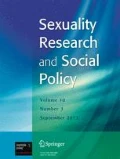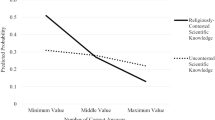Abstract
Introduction
Though religious conservatives espousing patriarchal views have historically been on the forefront of anti-pornography efforts in the USA, the past few decades have witnessed an increasing secularization of the anti-pornography movement. This shift is characterized by greater rhetorical dependence on scientific studies, secular anti-pornography activist groups, and arguments surrounding the protection of women from exploitation or abuse.
Methods
Using both aggregated and disaggregated data from the 1988–2018 General Social Surveys, we estimate a series of binary logistic regression models in order to examine the potentially changing connection between espousing a more patriarchal ideology and support for anti-pornography legislation, net of relevant correlates.
Results
Among Americans in general, embracing a more patriarchal ideology is positively associated with support for anti-pornography legislation across all survey years. Moreover, interactions indicate that Americans who adhere to a more egalitarian ideology, and particularly women, show a decline in their support for anti-pornography legislation over time.
Conclusions
Despite the prominence of feminist anti-porn groups and arguments in past decades, findings contradict the idea that support for strict anti-pornography legislation among the general public has ever been discernibly driven by egalitarianism. Rather, it has been and remains robustly connected to patriarchal beliefs and values prescribing traditionalist gender roles.
Policy Implications
Findings elucidate the dominant underlying gender ideology present in both historic and contemporary attitudes toward sweeping anti-pornography legislation and demand scholars and policy-makers disentangle rhetoric (of protection) from reality (patriarchy).

Similar content being viewed by others
Data Availability
All data for replication are available from www.NORC.org
Notes
Most studies of the social antecedents of Americans’ attitudes about restricting pornography’s availability have focused on the role of religious or political conservatism (Droubay et al. 2018; Query Jelen 1986; Patterson & Price, 2012; Perry, 2019, 2020; Sherkat & Ellison, 1997; Wood & Hughes, 1984) or change over time (Lykke & Cohen, 2015; Perry, 2019; Price et al., 2016). Recent work by Kohut, Baer, and Watts (2016) Query showed that persons who reported viewing pornography held more gender egalitarian attitudes, but controls in their study were quite limited and they did not examine support for anti-pornography legislation.
Because the original outcome variable included three possible values, ancillary models were also estimated using ordinal and multinomial logistic regression (see Appendix Tables 5 and 6; see also Fig. 2). While results were substantively similar, ordinal logistic regression violated the proportional odds assumption for all models. Multinomial logistic regression also provided results that were substantively similar to those presented here but were far more complicated to interpret once interactions were considered. Consequently, binary logistic regression provided a strategy that was both more consistent with the intention of the study and more parsimonious for interpretations.
References
Arizona, State of. (2019). House Concurrent Resolution 2009: A Concurrent Resolution Denouncing Pornography as a Public Health Crisis. https://www.azleg.gov/legtext/54leg/1R/bills/hcr2009h.pdf Accessed 31 May 2020.
Bernstein, E. (2012). Carceral politics as gender justice? The “Traffic in Women” and neoliberal circuits of crime, sex, and rights. Theory and Society, 41(3), 233–259.
Burke, K., & Haltom, T. M. (2020). Created by God and wired to porn: Redemptive masculinity and gender beliefs in narratives of religious men’s pornography addiction recovery. Gender & Society, 34(2), 233–258.
Burke, K., & MillerMacPhee, A. (2020). Pornography addiction discourse in science, news media, and politics: Knowledge production and biomedical sexuality. Social Forces. https://doi.org/10.1093/f/soaa035.
Cawston, A. (2019). The feminist case against pornography: A review and re-evaluation. Inquiry, 62(6), 624–658.
Cotter, D., Hermsen, J. M., & Vanneman, R. (2011). The end of the gender revolution? Gender role attitudes from 1977 to 2008. American Journal of Sociology, 117(1), 259–289.
Cowan, G. (1992). Feminist Attitudes Toward Pornography Control”. Psychology of Women Quarterly, 16(2), 165–177.
Cowan, G., Chase, C. J., & Stahly, G. B. (1989). Feminist and fundamentalist attitudes toward pornography control. Psychology of Women Quarterly, 13(1), 97–112.
Dines, G. (2016). Is Porn Immoral? That Doesn’t Matter: It’s a Public Health Crisis. The Washington Post. https://www.washingtonpost.com/posteverything/wp/2016/04/08/is-porn-immoral-that-doesnt-matter-its-a-public-health-crisis/?tid=a_inl Last Accessed 4 March 2020.
Droubay, B. A., Butters, R. P., & Shafer, K. (2018). The pornography debate: Religiosity and support for censorship. Journal of Religion and Health. https://doi.org/10.1007/s10943-018-0732-x.
Duggan, L., & Hunter, N. D. (2006). Sex wars: Sexual dissent and political culture. New York: Routledge.
Dworkin, A. (1981). Pornography: Men possessing women. New York: Putnam’s Sons.
Falwell, J. (1980). Listen, America! Garden City, NY: Doubleday.
Fight the New Drug. (2017a). How Consuming Porn Can Lead to Violence. https://fightthenewdrug.org/how-consuming-porn-can-lead-to-violence/ Last accessed 31 May 2020.
Fight the New Drug. (2017b). The Porn Industry’s Dark Secrets. https://fightthenewdrug.org/the-porn-industrys-dark-secrets/ Last accessed at 31 May 2020.
Foubert, J. D. (2017). The Public Health Harms of Pornography: The Brain, Erectile Dysfunction, and Sexual Violence. Dignity: A Journal on Sexual Exploitation, 2, 1–7.
Jelen, T. G. (1986). Fundamentalism, feminism, and attitudes toward pornography. Review of Religious Research, 28(2), 97–103.
Kohut, T., Baer, J. L., & Watts, B. (2016). Is pornography really about ‘Making Hate to Women’? Pornography users hold more gender egalitarian attitudes than nonusers in a representative American sample. Journal of Sex Research, 51(1), 1–11.
LaHaye, T. (1982). The battle for the family. Old Tappan, NJ: Fleming H. Revell Company.
Louisiana, State of. (2017). “House Concurrent Resolution No. 100.” https://legis.la.gov/legis/ViewDocument.aspx?d=1048213. Accessed on 31 May 2020.
Lykke, L. C., & Cohen, P. N. (2015). The widening gender gap in opposition to pornography, 1975–2012. Social Currents, 2(4), 307–323.
MacKinnon, C. (1992). Pornography, Civil Rights and Speech. In Pornography: Women, Violence and Civil Liberties, edited by Catherine Itzin. Oxford: Oxford University Press.
Nelson, K. M., & Rothman, E. F. (2020). Should public health professionals consider pornography a public health crisis. American Journal of Public Health, 110, 151–153.
Patterson, R., & Price, J. (2012). Pornography, religion, and the happiness gap: Does pornography impact the actively religious differently? Journal for the Scientific Study of Religion, 51(1), 79–89.
Perry, S. L. (2019). Addicted to lust: Pornography in the lives of conservative Protestants. New York: Oxford University Press.
Perry, S. L. (2020). Is support for outlawing pornography linked with ignorance or denial of science? Sexuality Research & Social Policy. https://doi.org/10.1007/s13178-020-00515-0.
Perry, S. L., & McElroy, E. E. (2020). Does the Bible tell me so? Weighing the influence of content versus bias on Bible interpretation using survey experiments. Journal for the Scientific Study of Religion, 59(4), 569–585.
Perry, S. L., & Whitehead, A. L. (2020). Porn as a threat to the mythical social order: Christian nationalism, anti-pornography legislation, and fear of pornography as a public menace. The Sociological Quarterly. https://doi.org/10.1080/00380253.2020.1822220.
Price, J., Patterson, R., Regnerus, M., & Walley, J. (2016). How much more XXX is Generation X consuming? Evidence of changing attitudes and behaviors related to pornography since 1973. Journal of Sex Research, 53(1), 12–20.
Scarborough, W. J., Sin, R., & Risman, B. (2019). Attitudes and the stalled gender revolution: Egalitarianism, traditionalism, and ambivalence from 1977 through 2016. Gender & Society, 33(2), 173–200.
Schnabel, L. (2016). Gender and homosexuality attitudes across religious groups from the 1970s to 2014: Similarity, distinction, and adaptation. Social Science Research, 55, 31–47.
Sharp, E. B., & Joslyn, M. (2001). Individual and contextual effects on attributions about pornography. Journal of Politics, 63(2), 501–519.
Sherkat, D. E., & Ellison, C. G. (1997). The cognitive structure of a moral crusade: Conservative Protestantism and opposition to pornography. Social Forces, 75, 957–980.
Smith, T. W. (1987). Strange bedfellows? (p. 15). GSS Topical Report No: An Analysis of Attitudes Towards Feminism and Pornography.
Steensland, B., Park, J. Z., Regnerus, M., Robinson, L., Wilcox, W. B., & Woodberry, R. (2000). The measure of American religion: Toward improving the state of the art. Social Forces, 79, 291–318.
Strub, W. (2010). Perversion for profit: The politics of pornography and the rise of the new right. New York: Columbia University Press.
Sumerau, J. E., & Cragun, R. T. (2015). ‘Don’t Push Your Immorals On Me’: Encouraging Anti porn advocacy in the church of Jesus Christ of Latter-Day Saints. Sexualities, 18(12), 57–79.
Taormino, T., Penley, C., Parrenas Shimizu, C., & Miller-Young, M. (Eds.). (2013). The feminist porn book: The politics of producing pleasure. New York: The Feminist Press.
Thomas, J. N. (2013). Outsourcing moral authority: The internal secularization of Evangelicals’ anti-pornography narratives. Journal for the Scientific Study of Religion, 52(3), 457–475.
Thomas, J. N. (2016). the development and deployment of the idea of pornography addiction within American Evangelicalism. Sexual Addiction & Compulsivity, 23(2–3), 182–195.
Utah, State of. (2016). “Concurrent Resolution on the Public Health Crisis.” https://le.utah.gov/~2016/bills/static/scr009.html Accessed on 31 May 2020.
Whittier, N. (2014). Rethinking coalitions: Anti-pornography feminists, conservatives, and relationships between collaborative adversarial movements. Social Problems, 61(2), 175–193.
Whittier, N. (2018). Frenemies: Feminists, conservatives, and sexual violence. New York: Oxford University Press.
Wood, M., & Hughes, M. (1984). The Moral Basis of Moral Reform: Status Discontent vs. Culture and Socialization as Explanations of Anti-Pornography Social Movement Adherence. American Sociological Review, 49(1), 86–99.
Wright, P. J., Bae, S., & Funk, M. (2013). United States women and pornography through four decades: Exposure, attitudes, behavior, individual differences. Archives of Sexual Behavior, 42, 1131–1144.
Author information
Authors and Affiliations
Corresponding author
Ethics declarations
Conflict of Interest
The authors declare that they have no conflict of interest.
Informed Consent
Informed consent is obtained by NORC.
Research Involving Human Subjects
General Social Survey data for this study are secondary, collected by NORC at the University of Chicago.
Additional information
Publisher’s Note
Springer Nature remains neutral with regard to jurisdictional claims in published maps and institutional affiliations.
Appendix 1
Appendix 1
Rights and permissions
About this article
Cite this article
Perry, S.L., McElroy, E.E. Protection or Patriarchy? Gender Ideology and Support for Anti-pornography Legislation, 1988–2018. Sex Res Soc Policy 19, 233–247 (2022). https://doi.org/10.1007/s13178-021-00537-2
Accepted:
Published:
Issue Date:
DOI: https://doi.org/10.1007/s13178-021-00537-2





